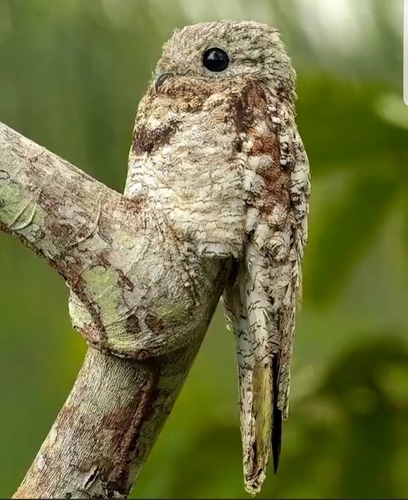
Great Potoo
The Great Potoo (Nyctibius grandis) is a near-passerine bird known for its exceptional camouflage and nocturnal habits. It plays a crucial role in its ecosystem as an insectivore, helping to control insect populations. This species holds a place in local folklore in some parts of its range, often associated with eerie nocturnal calls and its ghostly appearance when perched.
48-60 cm
Length
70-80 cm
Wingspan
Least Concern
Conservation Status
Distribution
The Great Potoo is found in Central and South America, ranging from southern Mexico through northeastern Guatemala and through most of Central America to South America as far as southeastern Brazil and Bolivia.
Lifespan
Unknown for wild, presumed several years based on related species.
Great Potoo's Habitat
Habitat Types
Humid lowland forests, Forest edges, Clearings with scattered trees, Sometimes near human settlements
Climate Zones
Tropical, Subtropical
Adaptations
Their cryptic plumage allows them to blend seamlessly with tree branches during the day, providing excellent camouflage from predators.
Variations
Two subspecies are recognized: *N. g. grandis* in eastern South America and *N. g. guatemalensis* from southern Mexico to Nicaragua.
Appearance
Breeding Plumage
No significant difference.
Seasonal Feather Changes
None
Sex Based Plumage Differences
Males and females have similar plumage.
Notable Features
Large, broad head, Huge yellow or orange eyes, Small bill with a wide gape, Mottled grey, brown, and black plumage for camouflage
Diet and Feeding
Primary Foods
Large flying insects, Beetles, Moths, Grasshoppers, Occasionally small bats and birds
Foraging Behavior
The Great Potoo is a sit-and-wait predator. It perches on a high, exposed branch at night and sallies out to catch insects in flight.
Specializations
Their wide gape allows them to capture large insects. Excellent night vision aids in hunting.
Seasonal Diet Variations
Diet may vary slightly depending on insect availability throughout the year.
Behavior
Social Structure
Generally solitary, except during breeding season.
Communication
Deep, guttural 'baaaaooo' call, Other croaking or clicking sounds, Visual posturing for camouflage, including the "freeze" posture
Migration
Generally non-migratory, though some local movements may occur in response to food availability.
Territorial or Group Behaviors
May defend a feeding territory, but generally not strongly territorial.
Conservation
Threats
Habitat loss due to deforestation, Pesticide use impacting insect prey populations
Protection Programs
Protected areas within its range offer some habitat security.
Local National Laws
Protected under general wildlife laws in many countries within its range.
Population Trend
Stable
Population Estimates
Difficult to estimate due to nocturnal and cryptic habits, but considered relatively common within suitable habitat.
Interesting Facts
They are masters of camouflage.
When perched, they adopt a 'freeze' posture, extending their head and body upwards to resemble a broken branch.
They have specialized eyelids.
They have slits in their eyelids that allow them to see even when their eyes are closed, aiding in predator avoidance.
Their large eyes reflect light.
Like many nocturnal animals, their eyes exhibit 'eyeshine' when illuminated at night.
Faqs about Great Potoo
Are Great Potoos dangerous to humans?
No, Great Potoos are not dangerous to humans. They are shy and avoid human contact.
What is the purpose of their call?
The call likely serves to establish territory and attract mates.
Where can I see a Great Potoo?
They are difficult to spot due to their camouflage. Visiting forested areas within their range at night and listening for their calls is the best way to find them, though patience and luck are required.
Copyright @ Nature Style Limited. All Rights Reserved.
 English
English